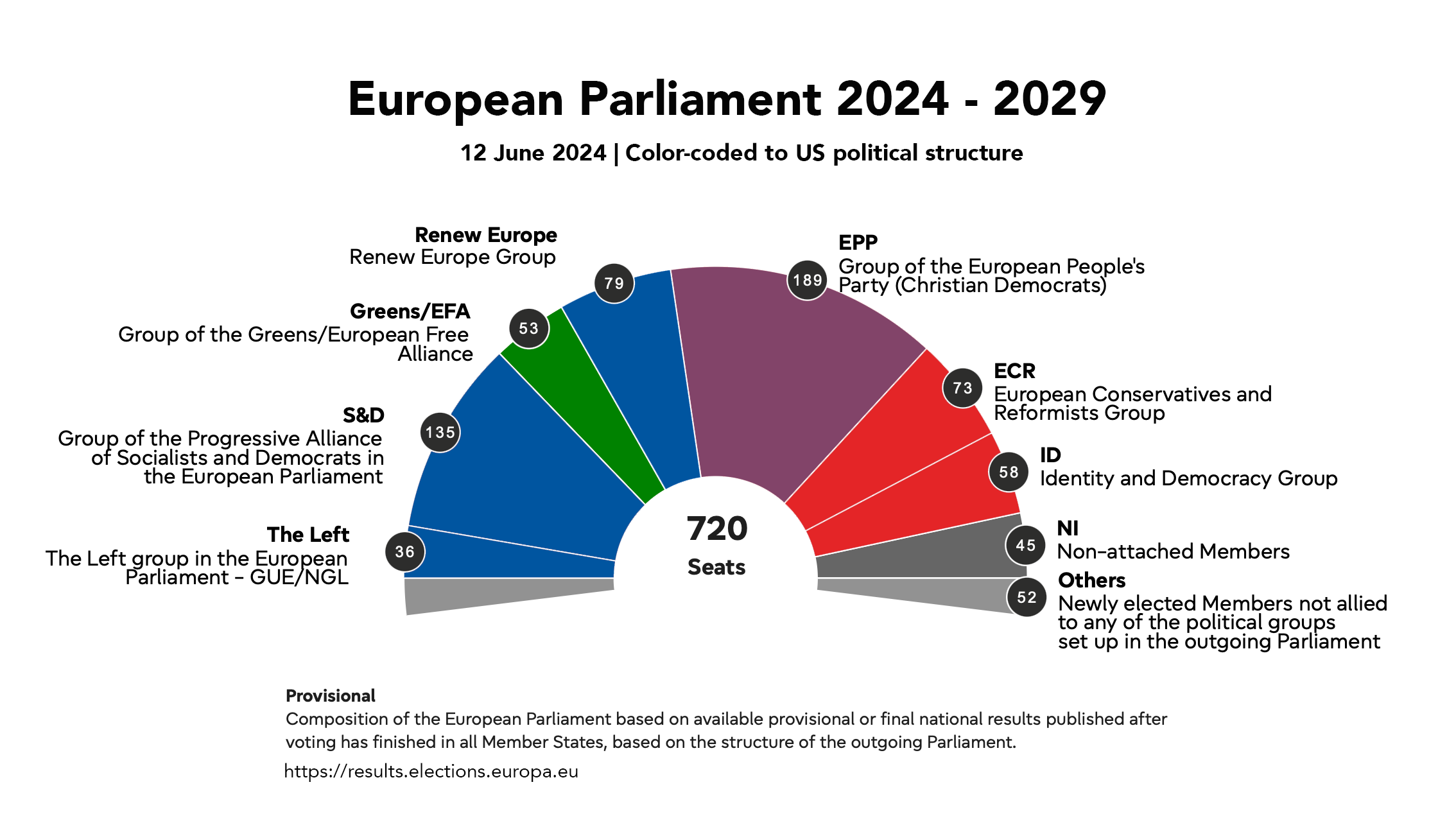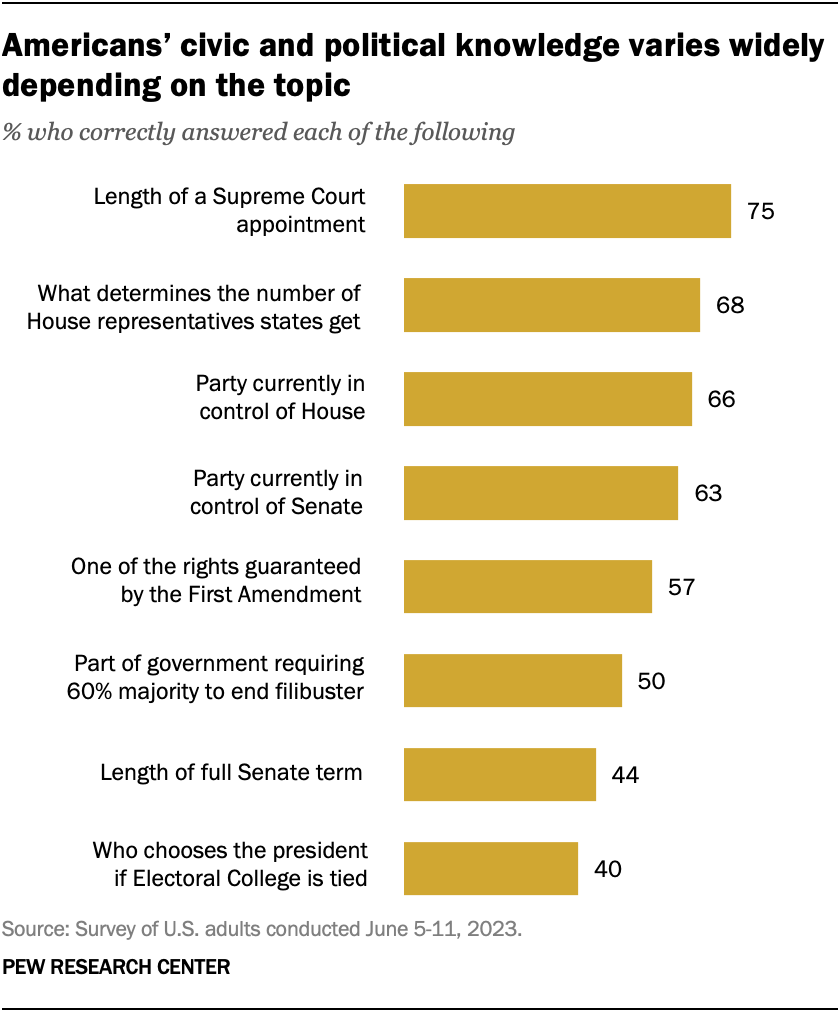With headlines like these, the average American probably believes that Europe is on the verge of a right-wing government. Such a belief, fed by a western media horse race style of reporting political news, is misplaced. This is not to diminish worrisome things that happened over the weekend. Rather, I’m arguing that the framing, with its focus on “winners and losers” sans context, represents journalistic malpractice. However, I’m certain it got clicks.
For all the drama in Berlin and especially Paris, the projections of a broader hard-right takeover of the EU do not appear to have materialised. The new parliament will lean further to the right, thanks in part to a poor showing by Socialists and especially Greens. But the wider shift to nationalist parties fizzled in many countries. The Economist, 09 June 2024.
The “combined hard-right forces” are expected to increase their seats from 20% to 22%.
That is clearly not a “sky is falling” statistic. Nor would I characterize it as “big gains,” like AP did. Two left-leaning parties went from 24% to 18% of the 720 seats.
Also, 14% of the MPs are currently non-aligned, an increase from 9% before this election. Compare that to the four independents in the U.S. Senate (4%) and no independents in the U.S. House of Representatives.
Going behind those headlines may make sense of what happened in Ohio on Tuesday.
In a special election, 6th Congressional district voters in Ohio elected Republican Michael Rulli to represent them in Congress. He defeated Democrat Michael Kripchak, 54.7% to 45.3%.
Republican Bill Johnson held the set for 13 years before retiring. He “won his last four elections by more than 30 points.” Two years ago, he won by 35 points. Plus, Trump took the district by 29 points in 2020.
Yet Rulli bested his opponent by only about 9 points after out raising Kripchak by a factor of 30.
This looks a bit like Hungary and Poland. (More in a moment.)
A word about the European Union
First things first: 27 countries comprise the European Union, ranging from Finland to Cyprus; from Ireland to Bulgaria. About 373 million were eligible to vote, including 16 year olds in Germany. Like the U.S. House of Representatives, seats in the European Parliament are distributed by population. Germany, for example, has 96 members of Parliament (MPs); France has 81; and Italy has 76.
Second: imagine if each U.S. state were a nation and that what happened in D.C. consisted of a lot of recommendations that were hands-off day-to-day lives of voters. That’s the EU Parliament, headquartered in Brussels. From The Economist: “Though they have few powers compared with national parliamentarians, their support is essential to enacting key EU-level policies such as cutting carbon emissions to net zero by 2050, or continued assistance to Ukraine.”
What is the good news from the European Union Parlimentary elections?
- The right underperformed pre-election polls. From Simon Rosenberg, “Veteran Political Analyst… One of the only ones who got 2022 right:”
“When people went to vote in Europe, not answer a poll, the right underperformed the polls this weekend. When voters had to make a real choice the right melted and lost ground. For like MAGA here, the European right is ugly and dangerous, affiliated with Putin, and when push came to shove many voters just couldn’t go there.” - The center made gains in authoritarian governments like Poland and Hungary. The party of Hungarian authoritarian leader Victor Orban had its worst showing. Ever. Voters believed Péter Magyar, who “has vowed to take back the billions in EU funds destined for Hungary that have been frozen by Brussels over rule of law concerns.”
How did AP characterize this setback? “Orbán’s party takes most votes in Hungary’s EU election, but new challenger scores big win” - It is unlikely that the vote will affect European support for Ukraine. As The Washington Post notes, “Joint decisions over sanctions and military aid are largely directed by individual states.”
And the troublesome news?
- Conservatives made gains in Germany, France and Italy. Perhaps, as Jay Kuo postulates, voters are signaling frustration and fear.
“Europeans face multiple crises, including low economic growth, high costs for nearly everything, a surge of migration from non-European regions, a faltering climate change agenda, and an increasing and even existential threat of Russian aggression. While many voters in Western Europe are signaling mistrust of the whole EU project and want greater national autonomy, many voters in the middle and south of the continent, where countries are facing internal autocratic threats and the possibility of outright invasion by Russia, want ever closer ties to Europe.” - In France, President Emmanuel Macron responded to voter’s sending more members of
Marine Le Pen’s far-right National Rally to Brussels by calling for an immediate (in three weeks) election for domestic matters.
Mujtaba Rahman, Europe head of the Eurasia Group, told Politico.eu: “I don’t think Le Pen will do as well in the legislative election, it’s a two round election, it’s a different group of voters who will be mobilized.” - In Germany, for the first time, 16 year olds were allowed to vote.
In 2019, one third of of the younger voters in Germany (18-24) voted for the Green Party because climate change drove their decision. In 2024, younger voters have turned conservative: And 16% of 16 to 24-year-olds voted for the far-right populist Alternative for Germany (AfD) party. In 2018, only 5% of 18-24-year-olds voted for AfD. Where else could 16 and 17-year-olds vote? Austria, Belgium, Malta and Greece.
What does the EU Parliament look like today (projected)?

Parliamentary systems of government tend to support a wider range of political parties and coaltions than a system like that in the United States. Here are the parties, as described by the BBC:
- European Conservatives and Reformists (ECR) is composed of “right-wing and far-right parties.”
- European People’s Party (EPP), “centre-right,” is composed of “Christian-democratic, liberal-conservative, and conservative member parties.”
- GUE/NGL, “left-wing”
- Greens/European Free Alliance, “liberal”
- Identity and Democracy (ID), composed of “right-wing and far-right parties” supports nationalistic, right-wing populist, positions.
- Progressive Alliance of Socialists and Democrats (S&D), officially founded as a Socialist Group on 29 June 1953. It is the second oldest political party in the EU.
- Renew Europe, “liberal”
It’s hard to expect Americans to understand European government, given our poor showing at home.
Did you realize that last November the BBC noted that the “US government has shutdown ten times over the past 40-plus years“? This is a uniquely American statistic. “Elsewhere in the world, such shutdowns are practically impossible.”
We are dysfunctional due to our two party system.
Perhaps our two party system is why too many potential voters seem to know too little about our system of government. Recent research from the Chamber of Commerce Foundation revealed that “[o]ne in three did not know there are three branches of government.” Hopefully, they don’t vote.
Pew Research data from November 2023 are not confidence-building, either.
Want to understand interntional affairs? Read the BBC, The Economist, The Guardian. Archive.today is your friend.
Talk to me: BlueSky | Facebook | Mastodon | Twitter
Known for gnawing at complex questions like a terrier with a bone. Digital evangelist, writer, teacher. Transplanted Southerner; teach newbies to ride motorcycles. @kegill (Twitter and Mastodon.social); wiredpen.com


















